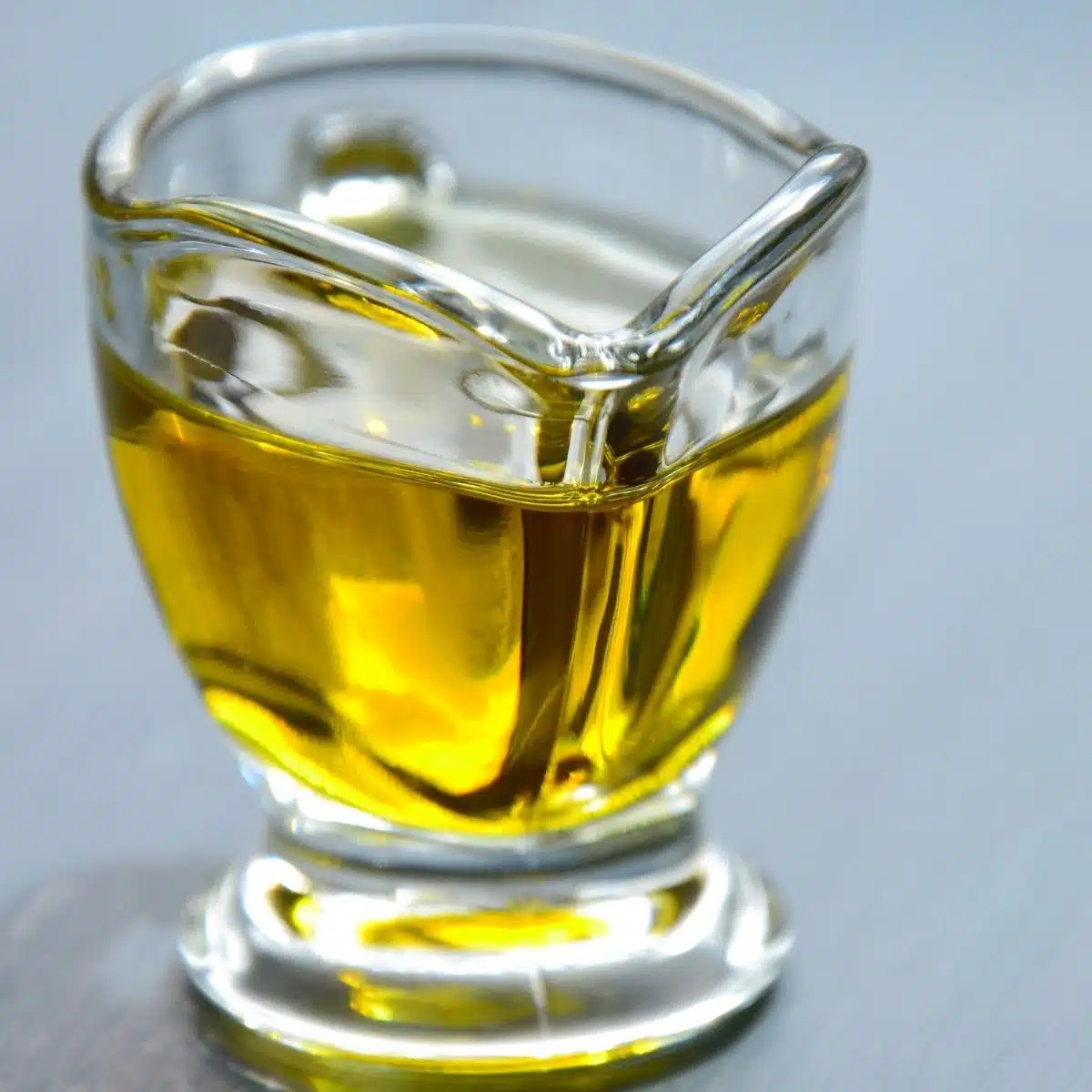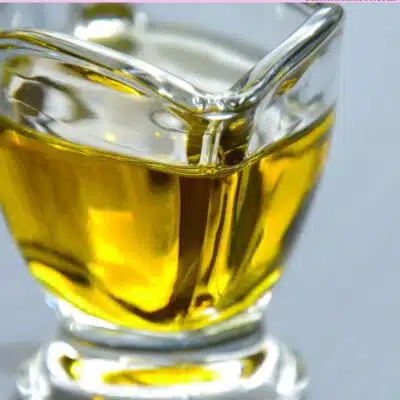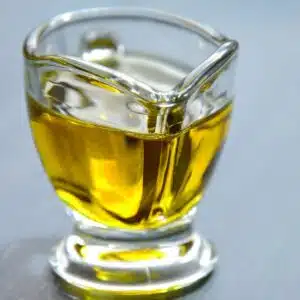Vegetable oil is used in recipes for many different reasons, so when choosing a vegetable oil substitute you need one equally as versatile! Whether you are cooking or baking, you need to know the best replacement for vegetable oil in case you ever run out!

A list of the best vegetable oil substitutes for all your cooking or baking needs!
Vegetable oil is one of those ingredients that gets used in so many different recipes, that you may easily run out without realizing it. In addition, as more and more people become aware of what types of ingredients they are cooking with – some feel that cooking with vegetable oil is not their healthiest option.
Whether you run out or are just want an alternative to vegetable oil for health reasons, there are plenty of choices.
Jump to:
Keep reading to find your new favorite vegetable oil substitute for baking and cooking. You may even be surprised to find that you can make a completely fat-free baked treat!
Choosing the Best Vegetable Oil Substitute
There are 3 main ways that vegetable oil is used in the kitchen: for high-heat cooking, baking, and making dressings. Therefore, choosing the best substitute depends on the purpose of the oil in the original recipe.
Vegetable Oil Substitutes for Cooking
Vegetable oil is a popular choice for cooking because it has a high smoke point. This means it can maintain its quality as an oil at high temperatures without smoking.
It is also considered a neutral-tasting oil. When you use vegetable oil in a dish it will absorb the flavors it is cooked with, rather than adding its own flavor. This is another reason it is a popular choice for cooking.
With these two elements in mind, the best substitutes for vegetable oil when cooking are going to be other neutral-flavored oils that have a high smoke point. These six are your best choices that will be the most like vegetable oil when cooking.
- Canola oil
- Safflower oil
- Peanut oil
- Grapeseed oil
- Avocado oil (avocado oil has a slight buttery taste that may slightly alter the overall taste)
- Ghee (ghee has a slightly nutty flavor that is delicious but may slightly shift the overall taste of your dish).
Each of these oils can be used in a 1:1 exchange for vegetable oil in any recipe. In addition to these four oils, there are some additional options that will work in certain situations.
The substitutes listed below can also be used as substitutes for vegetable oil in cooking. However, these alternatives do not have a high smoke point.
Therefore, you only want to use them in dishes where you are sautéing vegetables or meat – such as a stir-fry. For anything that needs to be fried, choose one of the oils above.
- Olive oil
- Butter
- Coconut oil
Beyond having a slightly lower smoke point than the other oils, these three alternatives also have their own distinctive flavors. Therefore, they will slightly shift the overall flavor of your dish.
Vegetable Oil Substitutes for Baking
Beyond its use as a fat for searing and sauteing, vegetable oil is a common ingredient in baked goods. In baking, this oil is used to add fat that helps to create moist breads, cookies, and cakes.
Leaving it out will leave you with a dry baked good. So, you definitely want to find a good replacement to keep the moisture and rich flavor of your favorite treats.
The nice thing about oil substitutes for baked goods is that you have a bit more flexibility since you don’t need to match the high-smoke point of the vegetable oil (like in cooking). This means you can even use some low-fat substitutes!
1. Canola Oil
Canola oil is the closest oil to vegetable oil. You can use it in any baked good in an easy 1:1 exchange. You will not notice any change in flavor or texture.
2. Sunflower Oil
Sunflower oil is often included in vegetable oil; therefore, using it on its own will provide the same result as vegetable oil. Use it in a 1:1 substitution for vegetable oil in any baking recipe.
3. Avocado Oil
Avocado oil is another great choice for baking, just like in cooking. While it is still high in fat, it is considered a “healthier fat” because it is lower in saturated fats than other oils.
Even though it has a slightly more distinct taste than other oils, when used in baking the flavor does not often come through. Use avocado oil in a simple 1:1 substitution for vegetable oil in any recipe.
4. Coconut Oil
Like avocado oil, coconut oil is another oil that has become popular due to its health benefits. A big difference between these two healthier oils though is the taste.
Coconut oil has a much stronger flavor profile than not just avocado oil, but vegetable oil. When using coconut oil as a substitute for vegetable oil, be mindful that the coconut taste may or may not pair well with the other flavors. Which, it probably will!
Chocolate coconut cookies are sure to be a yummy alternative to no cookies at all. When using coconut oil as a substitute, melt the oil first and then measure a 1:1 substitution for the vegetable oil.
5. Olive Oil
Cookies with olive oil? Yes! You can use olive oil to make your favorite treats. It will offer the same moisture and consistency as vegetable oil.
Olive oil will shift the overall flavor profile of the recipe though. When using olive oil in baking some of the flavor will “bake out.” However, you will notice a hint of that distinctive savory flavor associated with olive oil.
If you are looking to get creative in the kitchen though, this is a fun substitute to try! Easily swap out vegetable oil for olive oil in a 1:1 exchange.
6. Melted Butter
Butter is one of the tastiest choices as a fat substitute for vegetable oil in baked goods. One key difference in swapping out oil for butter is that butter has a lower percentage of fat than vegetable oil (oil is 100% fat while butter is only about 80%).
It also has a higher water content. While butter will add a delicious buttery taste to your baked goods, it will produce a slightly different texture due to the lower fat content and higher water content.
For example, cookies will spread more and be slightly crispy on the outside. Use butter in an equal 1:1 exchange for oil in your baking recipes. Melt the butter first, and then measure it to get the closest volume substitution for the oil.
7. Mayonnaise
Mayo is a surprisingly great substitute for baking. It won’t lower the fat content of your recipe, but it will add a lot of richness and moisture!
This is also a great choice because it is an ingredient that you probably already have in your fridge. Vegetable oil can be replaced with the same amount of mayonnaise in a 1:1 swap.
This swap works especially well with chocolate desserts, like a rich chocolate cake.
8. Greek Yogurt
Greek yogurt is like low-fat mayonnaise in baking. It has the same thick creamy texture and offers the same moisture content as mayonnaise. The biggest difference is that yogurt is naturally lower in fat than oil or mayo.
Therefore, you will lose a bit of the overall richness. However, the moisture will stay quite high. Replace vegetable oil with equal parts of plain Greek yogurt in your favorite baked goods.
9. Applesauce
Before Greek yogurt became popular in mainstream diets, applesauce was the original go-to for low-fat baking! This classic option offers the same benefits of moisture and a creamy texture that yogurt offers.
Not only is applesauce naturally 100% fat-free, but it also is naturally sweet. Therefore, you can leave out a little bit of the sugar (or another sweetener) if you choose.
This makes your baked treat just a little bit healthier, while still tasting completely indulgent. When substituting vegetable oil with applesauce, you only need ¾ of the volume: ¾ cup of applesauce for every 1 cup oil. (If you have a smaller quantity that is tricky to convert to a ¾ serving, go ahead and use an equal 1:1 exchange).
While a completely fat-free substitute is amazing, do keep in mind that the lack of fat from the oil will leave you with a denser baked treat.
Other Mashed Fruits
If you want to get creative with your fat-free baking, you can use other mashed fruits such as bananas and pears (or even pureed pumpkin) the same way you would use applesauce. Just remember that each of these will alter the taste slightly - as well as texture!
Vegetable Oil Substitutes for Dressings
Vegetable oil is a common ingredient in creating a base for many salad dressings and marinades. Since you don’t need to worry about the smoke-point with a dressing or marinade, you can truly substitute any other oil in place of the vegetable oil in an easy 1:1 exchange.
However, you are likely going to be using a large quantity of oil as the base. Therefore, be mindful of what additional flavors you may be adding in with another oil substitute.
Your best options for neutral flavors that will provide the most similar final taste as the original recipe are going to be canola, safflower, sunflower, grapeseed, and avocado oils. Olive oil is also a great choice though!
Remember that it is all up to your taste too, so just as with any of the other substitutions, feel free to explore what oils taste best to you and pair well with the dish you are making.
With our help, we hope you've found the perfect substitute for vegetable oil in your recipe! Let us know what you found most useful, and better yet, how your recipe turned out by leaving us a comment below!
Do you love a recipe you tried? Please leave a 5-star 🌟rating in the recipe card below and/or a review in the comments section further down the page.
Stay in touch with me through social media @ Pinterest, Facebook, Instagram, or Twitter! Subscribe to the newsletter today (no spam, I promise)! Don't forget to tag me when you try one of my recipes!
📖 Recipe Card
Vegetable Oil Substitute
Ingredients
Option 1 (Frying) - Canola Oil
- 1 tablespoon canola oil
Option 2 (Baking) - Butter
- 1 tablespoon butter
Option 3 (Dressings) - Avocado Oil
- 1 tablespoon avocado oil
(Note: 2x or 3x only changes the ingredient list)
Instructions
Option 1 (Frying) - Canola Oil
- Use canola oil in equal amounts to substitute for vegetable oil. It can handle the high heat of frying and is neutral in flavor.
Option 2 (Baking) - Butter
- Use melted butter in equal amounts as vegetable oil when baking. It adds great flavor and texture, but note that your cookies will be more prone to spreading as butter has a higher liquid content.
Option 3 (Dressings) - Avocado Oil
- My favorite swap for making homemade dressings and vinaigrettes is avocado oil. Use in a 1:1 equal ratio as the vegetable oil called for in any recipe.



Barbara T. says
Perfect. The recipe called for vegetable oil and I had none and wasn't sure what would be a good replacement. Turned out the olive oil was amazing in my cake mix and tasted excellent as well!
Lynn Brewer says
Would the conversion for using melted ghee for vegetable oil in my bread recipe, be the same as butter? For example: 1/4 cup melted ghee for 1/4 cup vegetable oil? I'm looking for a healthier option in my bread/rolls recipe that I make weekly.
Angela @ BakeItWithLove.com says
Yes, use ghee in equal amounts as butter for any recipe. Thanks for asking!
Kym Hrdlicka says
Any idea how it will affect a cake with to much oil *Olive oil* added?
Angela @ BakeItWithLove.com says
Like using too much oil in any cake mix or cake recipe, adding too much olive oil could result in a mushy but heavy cake. Additionally, the olive oil flavor would come through. Note that I use olive oil in cakes and brownies all the time and have never had enough olive oil to add that much flavor, or to be off-putting. Thanks for asking!